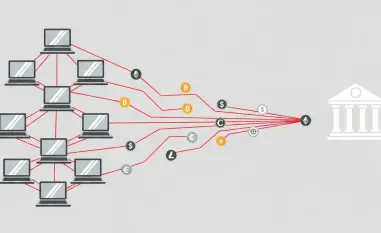As we approach 2025, the fast-changing cybersecurity environment necessitates a strategic approach to combat the increasingly sophisticated cyber threats driven by technological advancements. Both organizations and individuals must enhance their responsiveness by understanding emerging threats and implementing the necessary countermeasures to manage the challenges of an increasingly digital era. Strategically preparing for AI-driven cyber threats and embracing resilient and innovative solutions are critical steps in safeguarding our digital futures.
Organized cybercriminals are leveraging AI to create more complex and large-scale attacks, making it imperative to adopt advanced defense mechanisms. Below is an in-depth look at various strategies to defend against these AI-driven threats and other emerging risks in the coming years.
1. Defend Against AI-driven Attacks
Adopting defensive measures against AI-driven attacks can help individuals and organizations stay protected in an era where cyber threats are becoming increasingly sophisticated. One of the prevalent threats today involves deepfakes used to deceive through altered video and audio content, making it essential to verify the authenticity of messages. Always verify video or audio files’ authenticity through the correct channels to ensure they are genuinely from the person portrayed. Additionally, employing AI-based deepfake detection solutions can proactively identify harmful media.
Equally important is protection against AI-generated malware. As AI is employed to develop self-learning malware, traditional detection systems often fall short. To mitigate this, continuously update antivirus software capable of AI detection. Be vigilant about downloading apps and files exclusively from trusted sources to avoid malicious software. Take some practical steps to minimize risks from targeted phishing scams.
2. Personal Zero-Trust Principles
The zero-trust model challenges traditional perimeter-based security by continuously verifying access rather than assuming trust within the network. One way to bolster security is to activate multifactor authentication (MFA) on crucial accounts, such as banking, email, and social media platforms. Regularly review and restrict access permissions for applications running on your devices. It’s also prudent to limit temporary access to sensitive information, ensuring only essential personnel can obtain critical data, even if they are trusted individuals.
Implementing zero-trust principles helps reduce the risk of cyber incidents by fostering a culture of continuous verification and restricted access. By adhering to these principles, you effectively reduce potential attack vectors and enhance overall security.
3. Predict Risks of Quantum Computing
Quantum computing holds the potential to disrupt existing encryption methods, presenting new security challenges that will require organizations to rethink their cryptographic strategies. To stay ahead, it’s essential to closely follow developments in post-quantum cryptography and be ready to deploy these emerging technologies as they become available.
Avoid using legacy encryption protocols for confidential communications because quantum computers may eventually be able to break these with ease. Integrating quantum-safe services into encryption protocols ensures the secure transfer of sensitive information, even in a future quantum-computing landscape. Implementing end-to-end encryption services designed to withstand quantum threats can provide an additional layer of security, preparing organizations for impending advancements.
4. Protect Your IoT Devices
With the increasing proliferation of IoT devices, the network’s attack surface has expanded considerably. Ensuring the security of IoT devices begins with changing default passwords to strong, unique ones. Disabling any unused features on these devices is another critical step to reduce vulnerabilities.
Moreover, it’s crucial to keep IoT devices on a separate network from other systems. This segmentation minimizes the risk of an IoT breach affecting other critical systems. By maintaining strict security standards and segmenting networks, you limit the potential impact of cyber attacks on connected devices.
5. Ransomware Mitigation
Ransomware attacks have become more sophisticated, making robust mitigation strategies vital for prevention and recovery. One fundamental practice involves regular data backups, both offline and cloud-based, ensuring data can be restored in case of an attack. Testing these backups is crucial to verify that they function as intended and can be relied upon when needed.
Educational training about common phishing attacks for yourself and family members is also essential. Recognize and respond promptly to threatening messages that demand immediate action. Deploying advanced safety technologies, such as firewalls and endpoint protection, adds another defensive layer. These technologies can help secure networks from ransomware and other cyber threats.
6. Threat Intelligence
Staying informed about the ever-evolving cyber threat landscape is paramount for robust defense strategies. Linking up with updates from various advisories and communication channels, such as CERT-In or equivalent international bodies, provides valuable insights on emerging threats. Engaging with the cybersecurity community through public threat intelligence forums can further enhance awareness of vulnerabilities and exploits.
Blocking malicious domains with browser extensions or apps ensures safer web browsing by preventing access to and launch of harmful web pages. Continuous threat intelligence allows organizations to stay a step ahead in predicting and mitigating potential cyber attacks.
7. Setting Up Remote Work
As more organizations adopt hybrid work models, securing remote work environments remains a priority. Allow access to critical systems only through secure virtual private networks (VPNs) to create a secure communication tunnel. Strengthening Wi-Fi security with WPA3 and strong passwords ensures better protection against unauthorized access.
Separating work devices from personal devices is crucial to avoid mixing threats and data. This separation limits the spread of malware, ensuring that compromised personal devices do not endanger organizational networks. Implementing these security measures helps protect against threats associated with remote work.
8. General Good Practices
As the number of IoT devices continues to grow, the potential for network vulnerabilities increases significantly. Securing these devices starts with changing the default passwords to strong, unique ones to prevent unauthorized access. Additionally, it’s essential to disable any features on these devices that are not in use, as these can create unnecessary security weaknesses.
Another important measure is to place IoT devices on a separate network from other critical systems. This network segmentation helps to ensure that if an IoT device is compromised, the breach does not spread to more vital parts of the network. This strategy effectively isolates potential threats, minimizing the damage cyber attacks can inflict on connected devices.
Adhering to strict security protocols is vital to protecting IoT devices. Regular updates and patches should be applied to maintain the latest security defenses. Educating users about best security practices, such as recognizing phishing attempts and using two-factor authentication, further bolsters the overall security framework.
By implementing strong passwords, disabling unneeded features, segmenting networks, and maintaining rigorous security standards, organizations can significantly reduce the risk of cyber attacks impacting their IoT devices. Taking these preventive steps is crucial in safeguarding personal, professional, and industrial IoT environments from evolving threats.













